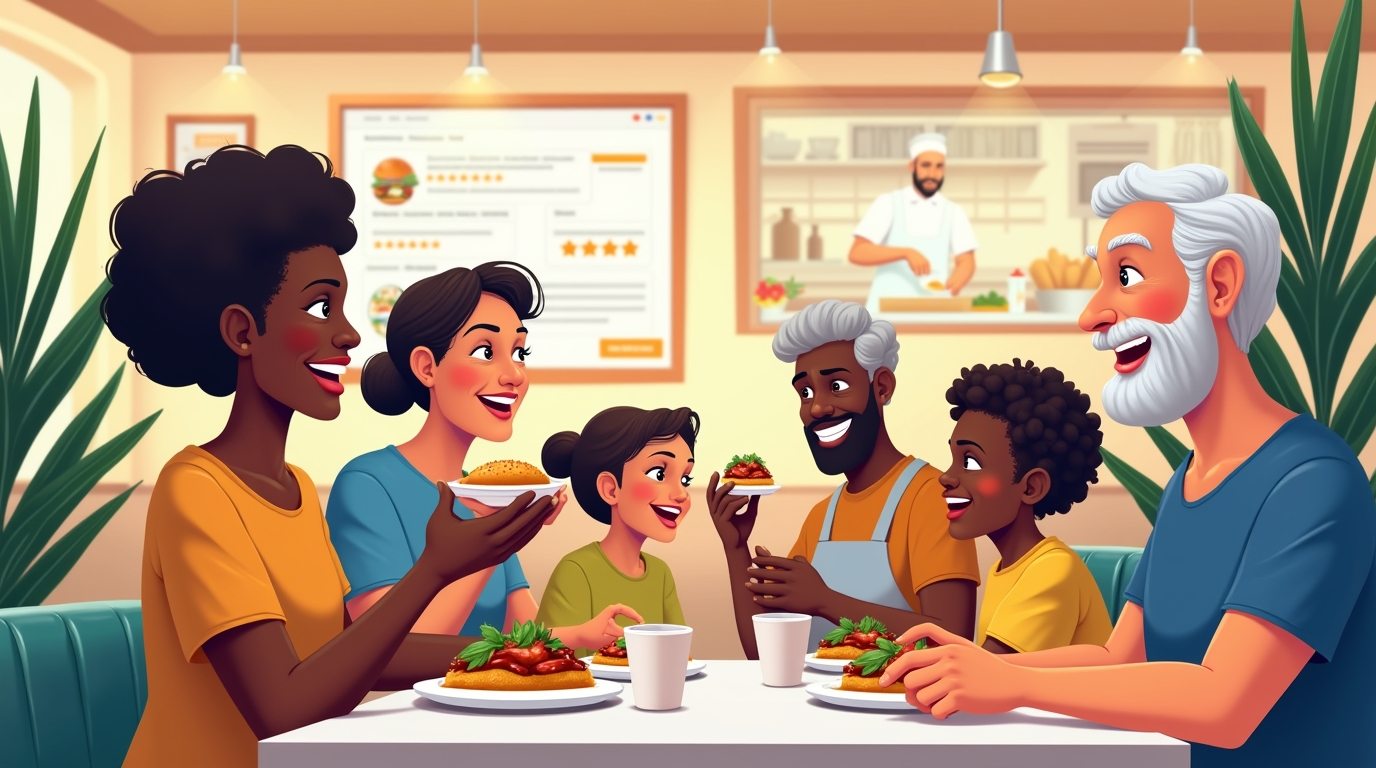In the digital-first environment of today, the success of a restaurant depends not just on how tasty its food tastes or how appealing its décor seems; it also depends on how readily hungry online clients may find you.
Whether you are managing a little neighborhood café or are a Michelin-starred chef, your capacity to draw clients today rests on visibility not only taste. Missing out on the contemporary equivalent of foot traffic online discovery means your restaurant is not visible where consumers are looking.
From local visibility and social media to everything a chef or restaurant owner has to know about getting discovered online, this manual breaks everything down with proven SEO for restaurant strategies, smart digital tactics, and reputation management.
1. Why “Being Found” Online Matters More Than Ever
Before we get into the how, let’s understand the why.
- 90% of diners research a restaurant online before visiting or placing an order.
- Over 70% of customers won’t visit a restaurant with a poor online presence — even if the food is great.
- Local searches like “best Italian near me” or “brunch spots nearby” now drive nearly half of all restaurant visits.
These numbers reveal a truth: digital visibility is now as important as your menu. You could have the best risotto in town, but if Google Maps, Instagram, or Yelp don’t highlight your restaurant, you might as well be invisible.
2. Claim Your Digital Real Estate
Just as you secure the best physical location for your restaurant, you need to claim your digital locations too.
Google Business Profile (GBP)
Your Google Business Profile (formerly Google My Business) is your restaurant’s front window on the internet. It’s what appears when someone searches your name or types “restaurants near me.”
Here’s what you need to do:
- Claim and verify your listing at google.com/business.
- Add accurate business info: name, address, phone, hours, and website.
- Upload high-quality photos — food, ambiance, and staff.
- Keep your menu updated and include links for reservations or ordering.
- Encourage customers to leave reviews and respond to them regularly.
A complete Google Business Profile can boost your visibility by over 70%. It’s often the first (and sometimes only) thing potential customers see before deciding where to eat.
3. Optimize Your Website for Hungry Searchers
If your website is slow, hard to navigate, or not mobile-friendly, you’re losing potential diners before they ever see your menu.
Make it Mobile-First
More than 80% of restaurant searches happen on mobile devices. Your site should load fast, look great on smartphones, and make essentials — menu, address, contact — instantly accessible.
Use Smart Keywords
Think like your customers. What would they type into Google?
Examples:
- “Vegan brunch in [Your City]”
- “Romantic dinner spots near me”
- “Best seafood restaurant downtown”
Sprinkle these phrases naturally throughout your website: homepage, menu page, and blog posts.
Include Local SEO Signals
Search engines love local cues. Add your city, neighborhood, and landmarks near you in your content and metadata. For example:
“Located just steps away from the [City Museum], our bistro offers locally sourced seafood in the heart of downtown.”
Add Schema Markup
This is a bit technical, but essential. Schema helps Google understand your content — like your hours, cuisine type, reviews, and menu — and display rich snippets in search results. A developer or SEO consultant can set this up for you in minutes.
4. Showcase Your Food with Visual Storytelling
Let’s face it: people eat with their eyes first. A single well-lit food photo can generate more traffic than a hundred words of description.
Invest in Professional Photography
Beautiful, high-quality photos of your dishes, dining area, and staff build trust and appetite. They also perform well on:
- Google Maps
- Instagram and Facebook
- Review sites (Yelp, TripAdvisor)
- Your website’s gallery or menu page
Use Video to Stand Out
Short-form videos (like Instagram Reels or TikToks) showcasing:
- Behind-the-scenes cooking
- Signature dish prep
- Chef interviews
- “Day in the kitchen” stories
These connect your audience emotionally to your restaurant and boost reach organically.
5. Be Active Where Diners Spend Their Time
Your digital presence isn’t limited to search engines — it thrives on social media.
Choose the Right Platforms
Focus on where food lovers hang out:
- Instagram for mouthwatering visuals.
- TikTok for storytelling and trends.
- Facebook for events, menus, and local engagement.
Post consistently — at least 3–4 times a week — and keep your tone authentic and personable.
Encourage User-Generated Content
Ask happy customers to tag your restaurant and share their experience. Reposting their content builds community and free exposure.
Run Local Ads
Even a small $5–$10/day ad budget can dramatically increase visibility within a few miles of your location, especially for special events, new dishes, or seasonal menus.
6. Reputation Is Everything: Manage Your Reviews
Online reviews can make or break a restaurant.
A single star difference on Google or Yelp can influence sales by up to 30%.
How to Build Positive Reviews
- Politely ask satisfied customers to leave feedback.
- Place a small reminder card on tables or receipts with your review link.
- Send a follow-up email after online orders or reservations.
How to Handle Negative Reviews
- Never ignore or delete (unless fake/spam).
- Respond promptly and professionally.
- Acknowledge the issue and offer to make it right offline.
Your public response shows you care — not just to the reviewer, but to every future customer reading.
7. Content Marketing: Share Your Expertise
You’re not just serving food — you’re sharing a story, a philosophy, a passion. Content marketing helps communicate that and draws in organic traffic.
Blog Ideas for Chefs
- “How to Pair Wine with Seafood”
- “Our Farm-to-Table Journey”
- “Behind the Scenes of Our Seasonal Menu”
- “The Secret to Perfectly Grilled Steak”
Each blog post is another door into your restaurant from Google search results. Use them to educate, inspire, and subtly promote your brand.
Collaborate with Local Influencers
Invite local food bloggers or influencers to dine in exchange for honest reviews or social coverage. Their posts can reach thousands of potential diners who trust their opinions.
8. Track What’s Working
You can’t improve what you don’t measure.
Use free tools like:
- Google Analytics: See how people find your website.
- Google Search Console: Discover what keywords people use to find you.
- Meta Insights / Instagram Analytics: Track engagement, reach, and audience demographics.
Pay attention to:
- Which pages get the most visits.
- Where your visitors come from.
- Which posts or photos get the most engagement.
Use this data to refine your strategy. For instance, if your “Vegan Menu” page gets a lot of hits, promote it more heavily on social media or create related content.
9. Local Partnerships and Listings
Don’t underestimate the power of local connections online.
- List your restaurant on local directories and food apps (TripAdvisor, Yelp, DoorDash, OpenTable, Zomato).
- Partner with nearby businesses — like local farms, bakeries, or wineries — for cross-promotion.
- Sponsor local events or food festivals, then share those moments online for PR value.
This not only boosts SEO through backlinks but strengthens your reputation as part of the community.
10. Embrace Evolving Technology
The digital dining landscape is constantly changing. Chefs who adapt early stand out.
Voice Search
People increasingly ask their smart devices:
“Where’s the best pizza near me?”
“What’s open for brunch right now?”
Optimize your content for natural, conversational phrases to capture these searches.
Online Reservations & Ordering
Integrate services like OpenTable, Resy, or Toast so customers can book or order directly from your website or Google listing.
AI & Chatbots
AI-powered chat widgets can answer FAQs, show menus, or take bookings automatically — freeing up your staff while improving customer experience.
11. Build a Brand That Tells a Story
Visibility will get customers through your door, but branding keeps them coming back.
Ask yourself:
- What’s my restaurant’s personality?
- What emotions do I want to evoke?
- What’s my story — and how am I telling it online?
From your logo to your tone of voice on social media, everything should feel consistent. People don’t just choose food — they choose experiences and identities.
12. Keep Learning and Experimenting
Digital marketing is never “done.” Algorithms shift, new trends emerge, and customer habits evolve.
The best chefs apply the same mindset to marketing that they use in the kitchen:
- Experiment with new ideas.
- Test different “recipes” for success.
- Refine what works and discard what doesn’t.
Follow restaurant marketing blogs, take online courses, or work with a digital marketing consultant for professional guidance.
Conclusion
Hospitality doesn’t begin when a customer sits down it starts the moment they discover you online. Your digital presence is your new front of house. The warmth of your website, the allure of your photos, the authenticity of your responses, and the clarity of your information all shape first impressions. Being found online isn’t just about ranking higher it’s about building trust before the first bite. Chefs who embrace this mindset aren’t just cooking for the table; they’re serving an experience that begins in the search bar and ends in a satisfied smile.



